Australian Reporting Season: Full-time Match Report

Wilsons Advisory
Major Upgrade Themes
Cost disinflation and cost-outs an earnings tailwind for some
Some of the largest earnings upgrades this reporting season have been on the back of easing cost pressures.
James Hardie’s (ASX: JHX) stellar Q1 earnings and Q2 upgrades were driven in part by the disinflation of freight and raw material costs over the year (compared to an elevated base year), which, in combination with price/mix gains, has helped to offset macro-driven volume softness.
A raft of companies also received earnings upgrades after they announced cost-out programmes aimed at improving their profitability, including AMP (ASX: AMP), Qantas (ASX: QAN), Orora (ASX: ORA), Qube (ASX: QUB).
Sector tailwinds
A number of sectors are still in upgrade mode on the back of favourable sector-specific trends.
Insurance – general insurers and insurance brokers, like IAG (ASX: IAG), Suncorp (ASX: SUN) and Steadfast (ASX: SDF), have continued to benefit from improving profitability trends driven by continued momentum in the insurance premium rate cycle.
Travel – the ongoing post-covid recovery is continuing to drive upgrades to consensus forward earnings estimates for Qantas, although we are increasingly of the view that the market is ‘looking through’ current strength to more normalized earnings.
Figure 1: Major earnings upgrades ASX 200




Click to enlarge. Source: Refinitiv, Wilsons.
Major Downgrade Themes
Stickier cost items continue to weigh on some companies’ margins
While some businesses have benefited from cost disinflation this reporting season, a range of key costs items (namely labour, rents, and debt costs) have proved sticky and continue to act as a headwind for labour intensive industries, businesses with significant occupancy costs (e.g. retailers), and indebted businesses, in particular.
Ramsay Healthcare (ASX: RHC) and Endeavor Group (ASX: EDV) both received earnings downgrades this reporting season as their outlook is being hampered by higher-than-expected interest costs. Coles (ASX: COL) also underwhelmed consensus expectations due to a higher cost of doing business driven by higher wages, rents, and a tick up in theft.
Meanwhile, both Wisetech (ASX: WTC) and Seek’s (ASX: SEK) earnings guidance has been weighed down by the near-term margin dilution associated with recent merger and acquisition (M&A) activity and investment into growth initiatives.
Sector headwinds
Several sectors are facing cyclical headwinds that have weighed on near-term earnings expectations.
Manufacturers – both Ansell and Amcor have been impacted by inventory destocking from their customers, which follows a period where customers accumulated stock amidst covid-related supply chain dislocations. Both companies have highlighted that despite the destocking headwind in FY23, end-user demand has still remained relatively resilient, while destocking trends are expected to stabilise/ease by the second half of FY24.
Media / Online Classifieds – the softer macro environment has translated to a subdued ad market backdrop, which has driven earnings misses for companies like Nine Entertainment (ASX: NEC) and Seek.
Office landlords – A-REITs with significant office market exposures like Dexus (ASX: DXS) and Growthpoint Properties (ASX: GOZ) and have faced both cyclical (i.e. labour market conditions, higher cap rates) and structural headwinds (from work-from-home), which we expect to weigh on asset valuations and operating metrics through FY24.
Figure 2: Major earnings downgrades ASX 200





Source: Refinitiv, Wilsons.
Unpackaging Amcor’s value: Adding at 3%
We have screened the ASX for other stocks that could provide cost disinflation upside over the medium-term, and Amcor (ASX: AMC) is a standout.
Significant upside over the next 12-24 months
We believe AMC can materially outperform the benchmark over the next 12-24 months. The key to our investment thesis is:
- Worst is behind us: The abatement of headwinds - global destocking and elevated costs - which have knocked earnings forecasts and investor confidence.
- Upgrades: We expect earnings to recover quicker than expected as these two headwinds subside.
- Attractive valuation: AMC looks cheap and we expect a rerate as these headwinds subside.
AMC overview: Resilient end market, global reach
Amcor boasts a commanding position within the global packaging solutions sector. The company operates in 43 countries with 220 locations from the US to emerging markets (EMs). 95% of sales are to consumer end markets and major customers include global titans Unilever, Nestle, Proctor and Gamble, J+J and Coca-Cola.
The end-use sector mix is largely defensive in nature. A large portion of sales (FY22) are focused on food (43%), beverage (26%) and healthcare (13%), acknowledged for steady and steadfast demand, usually offering stability even amid broader economic fluctuations.
Figure 3: AMC's end-use sector mix is mostly defensive (LHS) Figure 4: AMC is a truly global company (RHS)
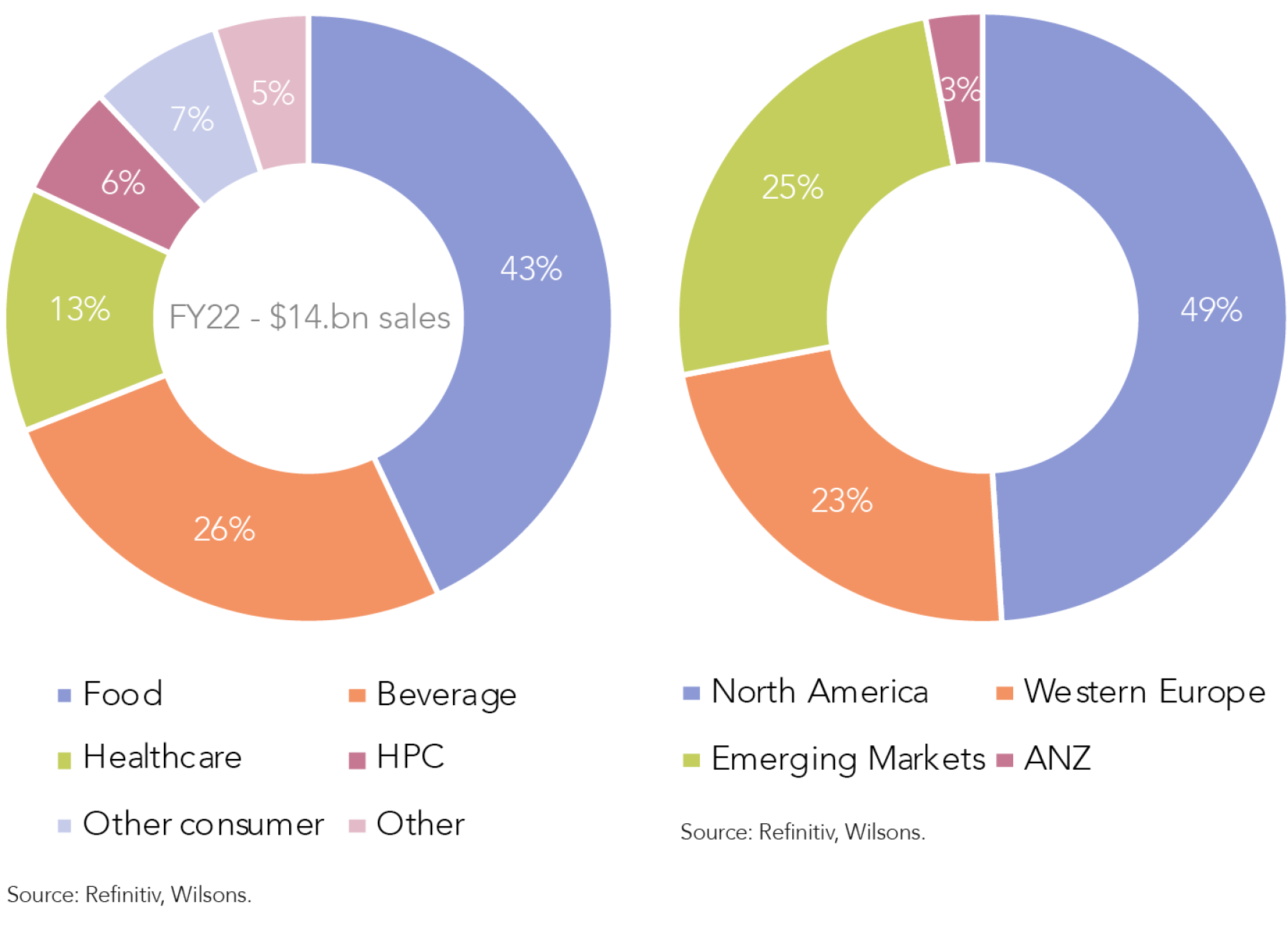
Returns we expect over the cycle
We expect AMC to generate a total shareholder return of 10-15% over the cycle. This is driven by 3 key areas. First, is capital expenditure reinvested into the business such as R+D spend or expanding capacity, this grows earnings organically. Second, through buy-backs or M&A activity. AMC has invested over $5bn on acquisitions and buy-backs since 2010. Third, dividends. AMC has consistently paid a 4-5% dividend yield over the last decade. All this together provides a total return that is historically higher than the index.
Figure 5: Annual earnings growth and dividend yield have typically been above total market returns
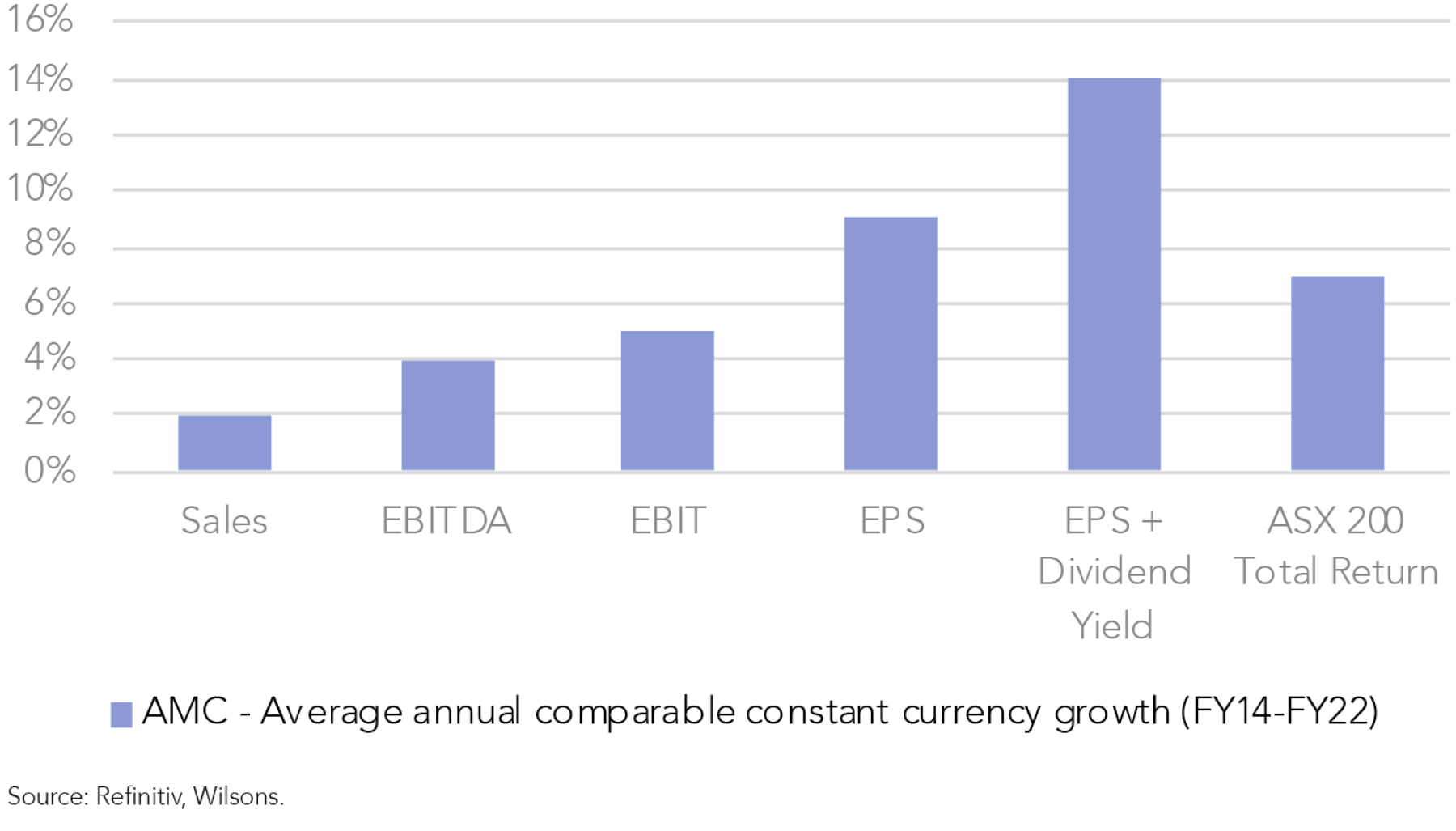
Figure 6: AMC margins have expanded as it has scaled and via reinvestment
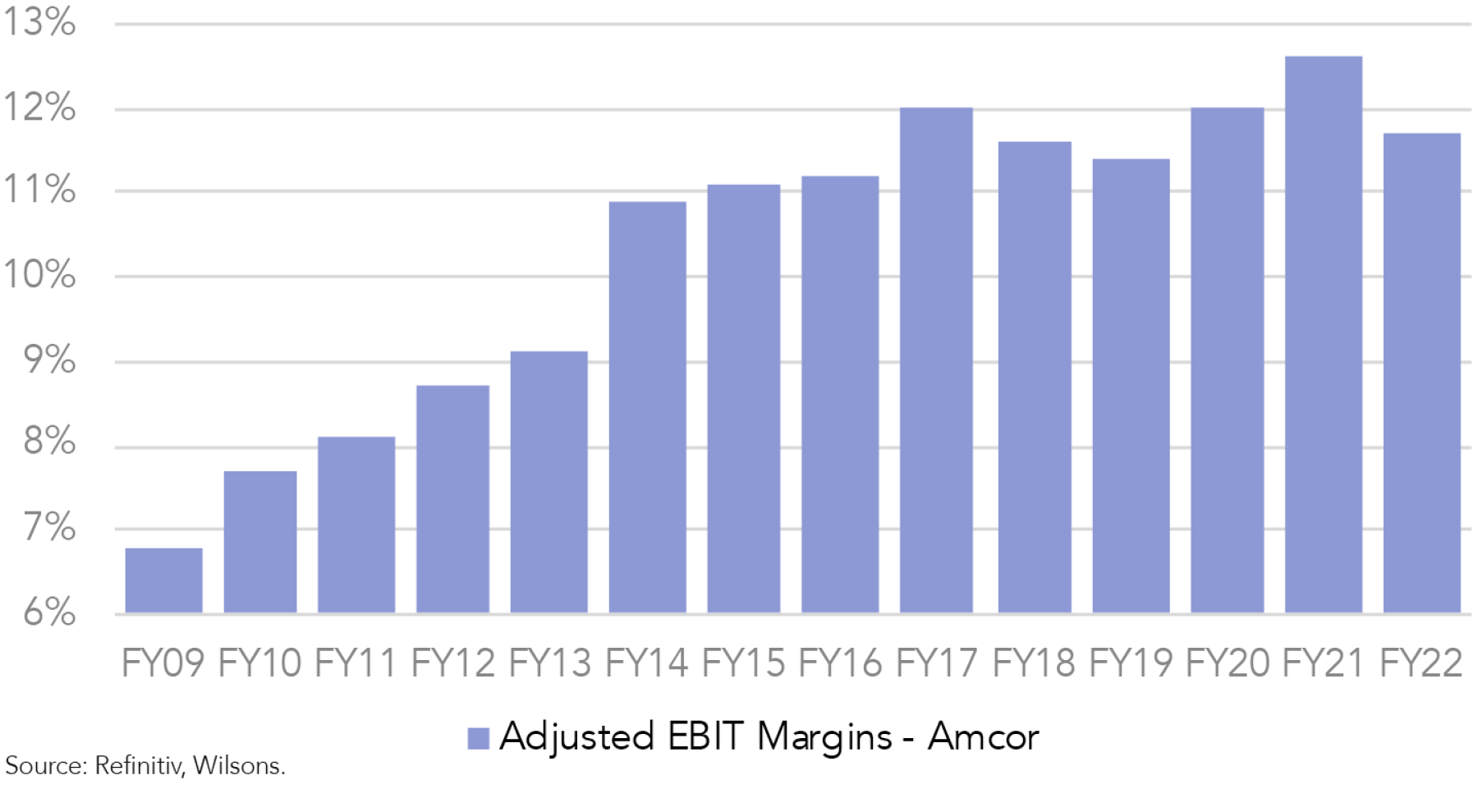
Deciphering the destocking
AMC’s volumes and margins have suffered due to global destocking. The US in particular has seen significant destocking since last year. In 2022, retailers (including food and beverage retailers) built up a level of inventory that soon became unsustainable, due to:
- Supply Chain Challenges: Persistent supply chain dislocations resulting from the pandemic triggered a change in retailer buying patterns. Retailers ordered products earlier to ensure they had enough during busy seasons and even ordered more to prepare them for potential disruptions.
- Shift to "Just-in-Case": US food retailers shifted from ordering only what's needed (just-in-time) to ordering more to be safe (just-in-case).
- Cost of living impact: As interest rates and inflation increased, consumers tightened their spending.
- Inventory Mismatch: With consumers buying less and retailers ordering more, the balance between what was in stock and what was wanted shifted. This resulted in excess inventory that needed to be adjusted.
Destocking adversely impacted Amcor operations via:
- Lower Volumes: Destocking has reduced order volumes for AMC's packaging products in recent reports.
- Price Pressures: In a destocking environment, customers might exert pressure on suppliers like Amcor to reduce prices or offer discounts.
- Difficulty Passing on Cost Increases: AMC faced higher costs in its supply chain, such as higher raw material, production costs or freight. Subsequently, the company has found it challenging to pass these increases onto customers in an environment of soft demand, which has crimped margins.
Destocking risk moderating
We are now seeing evidence that the destocking cycle is easing. US data on food and beverage inventory levels provide evidence of a slowdown and return to trend growth. Furthermore, food and beverage sales data have started to turn positive as the US consumer proves resilient in the face of higher interest rates.
Figure 7: Data suggest destocking is slowing and could be coming to an end
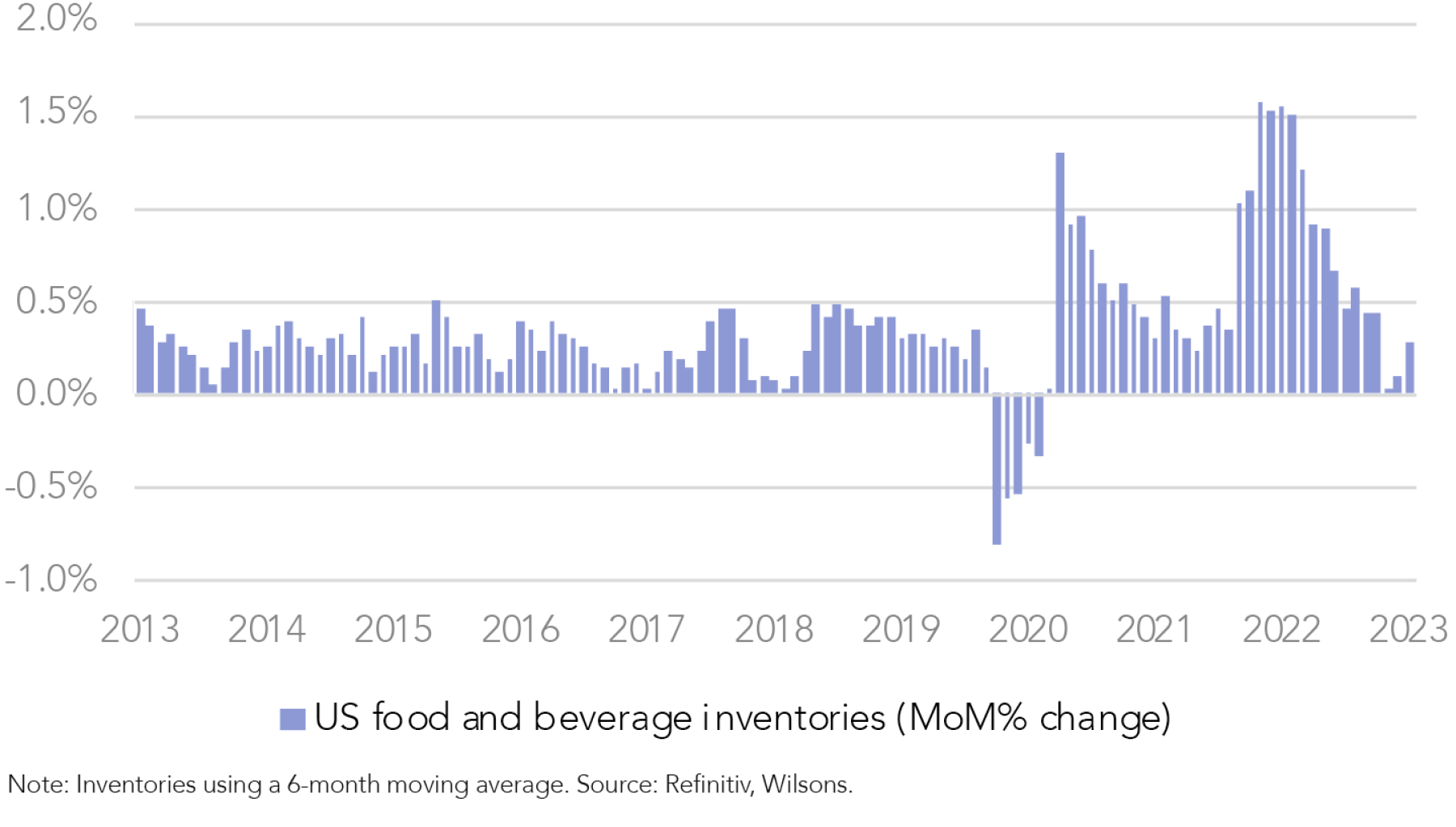
Figure 8: New orders and inventories for manufacturing have weakened but are now showing signs of improvement
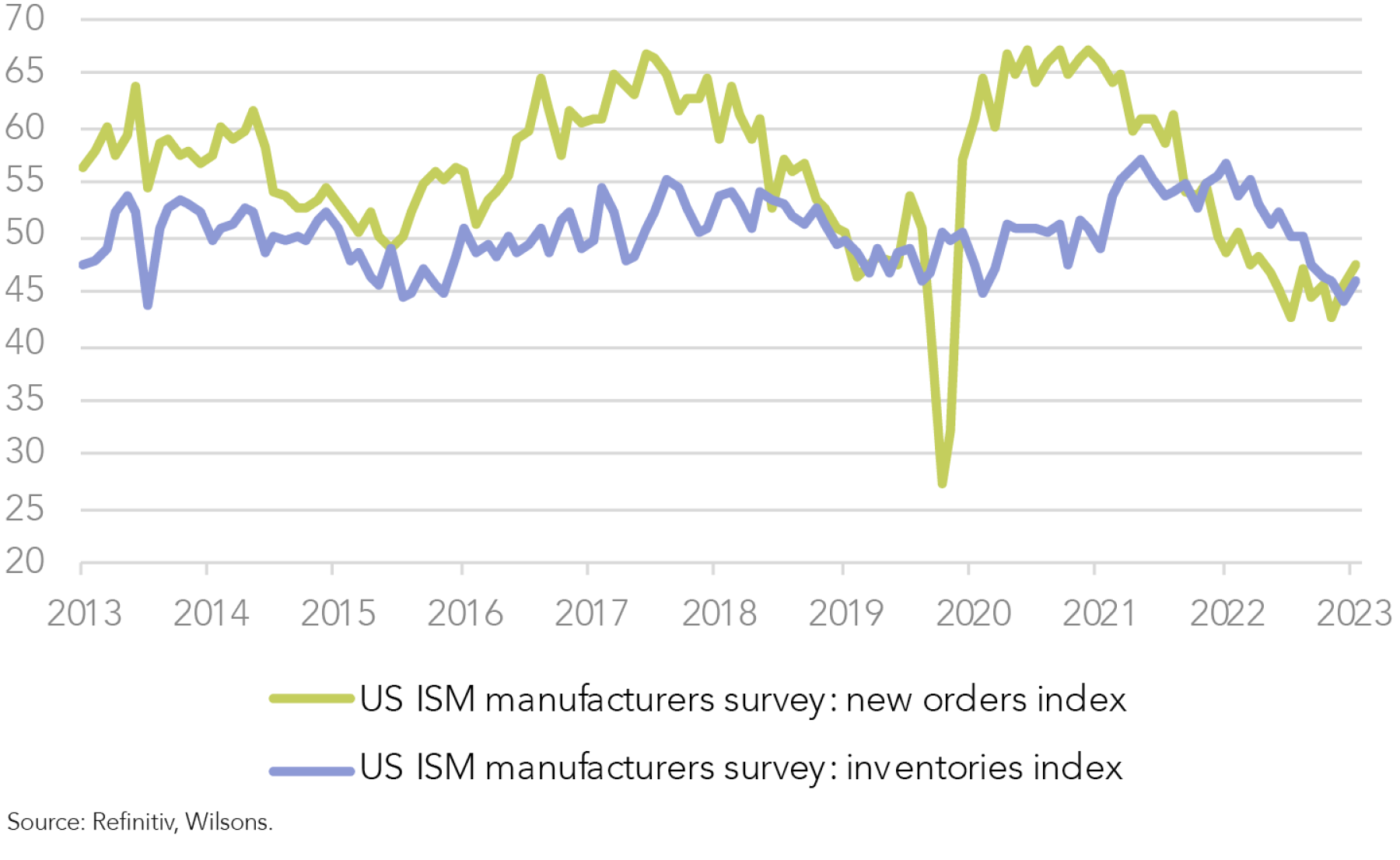
Major retailers are getting more positive on their inventory levels. Walmart (>50% of US revenue is from grocery sales) discussed in its recent results how it “made good progress” in reducing inventory levels and is more focused on reducing exposure where it is seeing declining sales such as electronics and home goods. Costco also recently discussed its destocking over the past 6 months, but like Walmart, was a lot more comfortable with its inventory levels in June.
AMC is now more positive on destocking. Management discussed in the recent result that they expect destocking will abate and be largely behind us by the end of this calendar year.
We expect this destocking was a one-off for AMC after an unusual inventory cycle over the pandemic. AMC’s end consumer has proven to be resilient.Once destocking is complete, we should see a quick return to volume growth. Operating leverage will drive results as volumes improve.
We expect a more rational cycle over the medium term. In a more rational cycle, AMC should be able to pass on more costs to customers and volumes should grow at normal levels.
Downside risk to costs, upside risk to margins
In a period of lower volumes, AMC's higher costs could not be fully passed along to their customers, and margins contracted as a result.
Costs can fall quickly, as we saw with James Hardie (JHX) in their recent result. AMC’s cost profile is very similar to JHX. Like JHX, AMC’s freight and raw material costs could decrease within the next few quarters, providing an upside risk to FY24 earnings.
AMC, like JHX, has been increasing prices over the past year, but costs swung margins the wrong way. A period of lower costs and elevated prices could lead to a significant beat to earnings expectations via margin expansion.
Margins in consensus look too low when you consider the risk of cost disinflation and the end of destocking. A 1 percentage point increase in FY24 net income margins would lead to a ~9% increase in earnings (keeping revenue constant). We think the risk to margins is to the upside, with FY24 representing a low point in margins.
Figure 9: We think there is upside risk to FY24 and FY25 margins, mainly due to costs
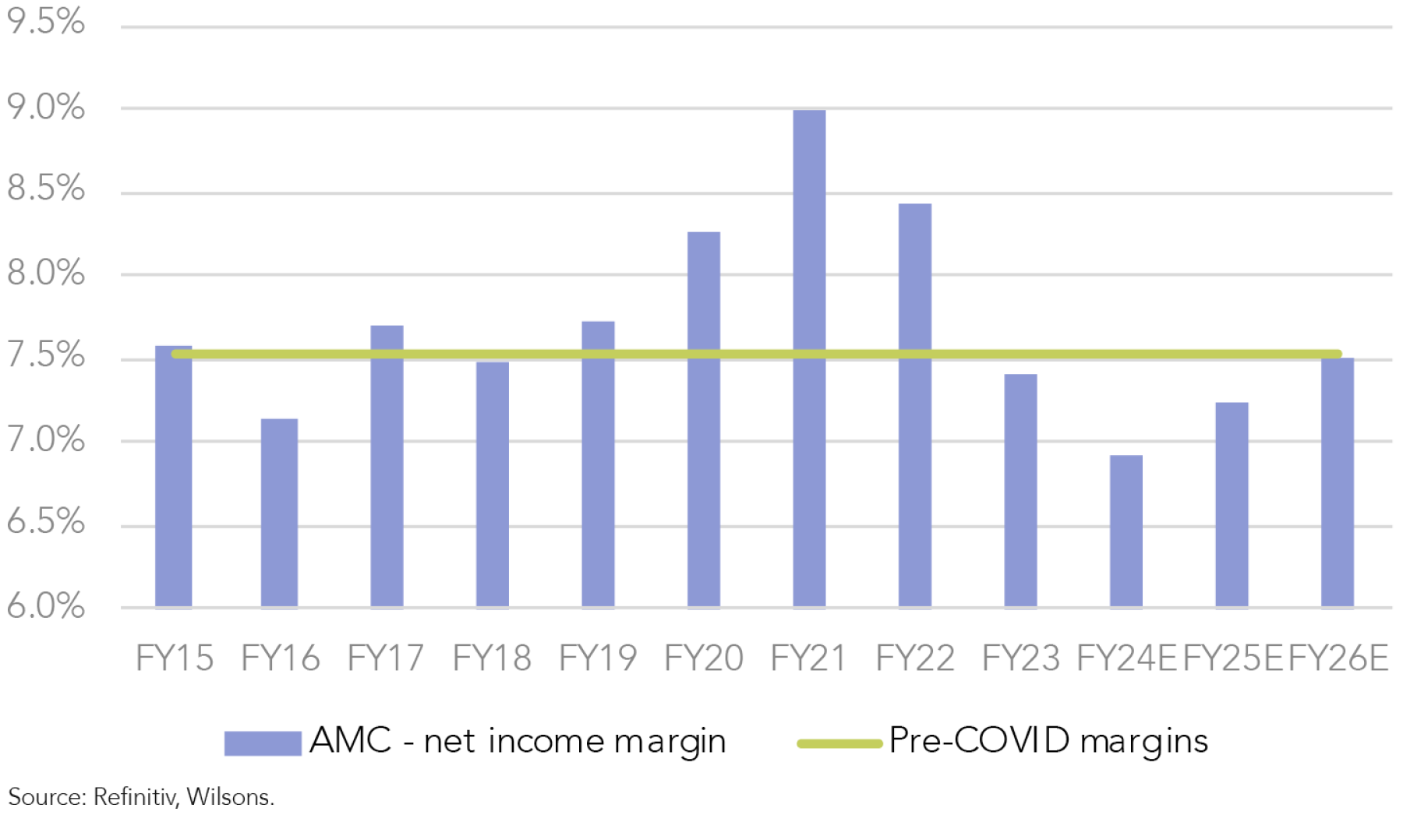
Attractive Valuation
Amcor's valuation is attractive. Trading at approximately 13.7x on a 12-month forward price to earnings (PE) basis, the stock is trading below its 5-year (15.4x) and 10-year average (16.6x). At 13.7x with an expected earnings annual growth of 7% from 2024-2027, AMC’s PE has upside risk, in our view.
The current discount to the five-year average PE suggests the market is factoring in an expected earnings downgrade of approximately 11.5%. We believe downside risk to earnings is now minimal. Significant deterioration in volumes and earnings seems a low-probability outcome.
Figure 10: Based on 5- and 10-year averages, we believe AMC’s PE has upside risk
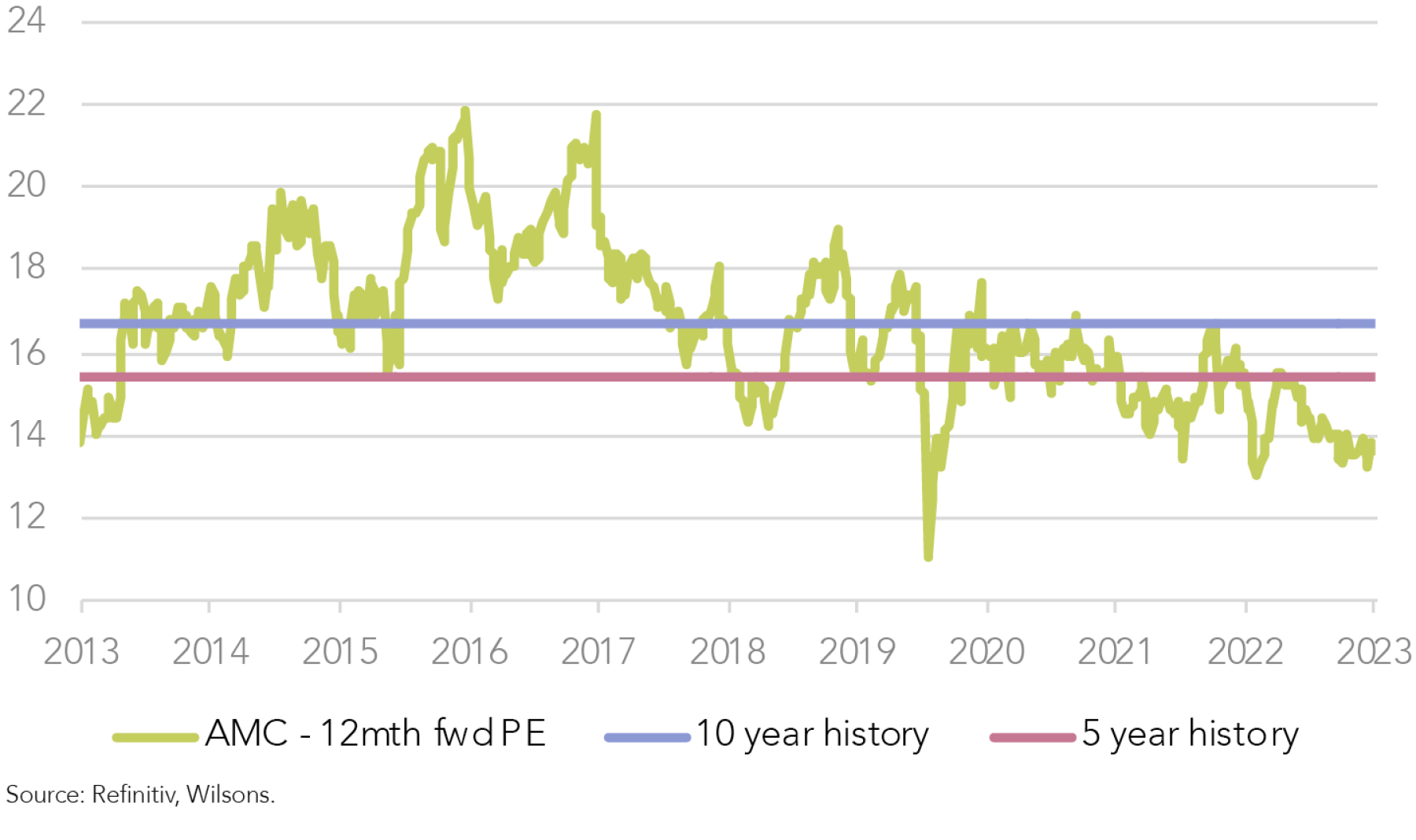
Dividend also looks attractive at 5% (12mth fwd). This is at the top of the range for AMC and above its historical 10 year average of 4.4%.
Figure 11: Dividend yield looks attractive at these levels
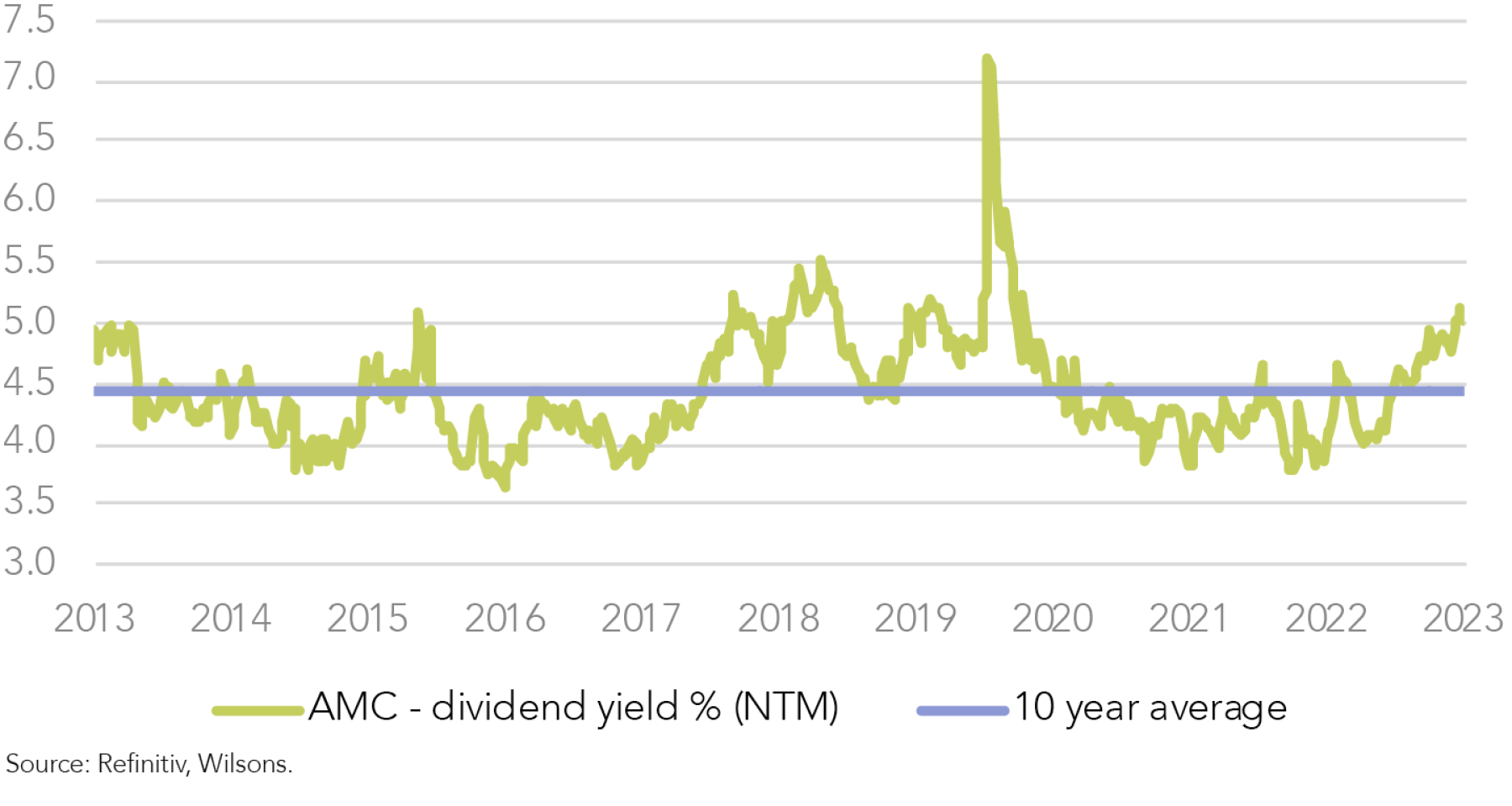
Against other defensives, AMC represents good value from a growth to valuation perspective, with upside risk to valuation and growth.
Figure 12: AMC looks the cheapest defensive on the market, with reasonable growth prospects
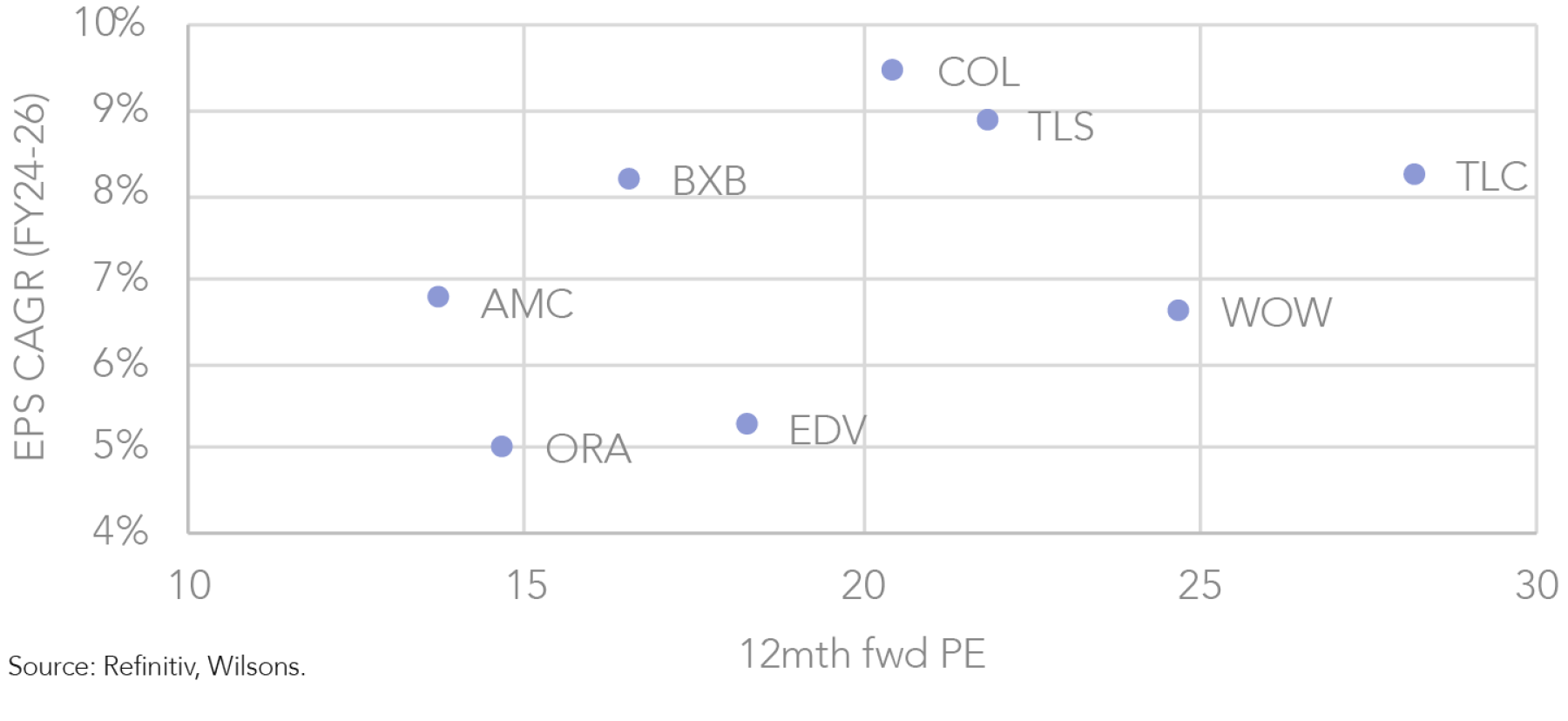
Want more insights like this?
WILSONS thinks differently and delves deeper to uncover a broad range of interesting investment opportunities for its clients. To read more of our latest research, visit our Research and Insights.
22 stocks mentioned

Expertise

